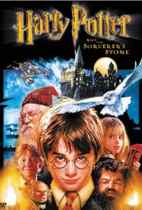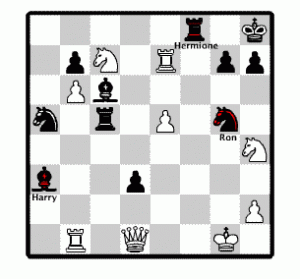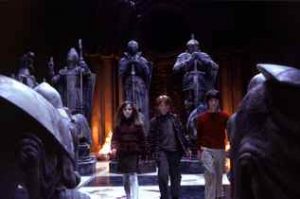Creating the Harry Potter Chess Position
Jeremy Silman

When I was asked to create the chess position for Harry Potter And The Sorcerer’s Stone, I was more than delighted. Throughout my life, I’ve watched movies and TV shows make a joke of real chess positions and real chess lingo. Now, after years of seething, I finally had a chance to do the job right.
My gripes were the following:
* When referring to an opening system, the actors would never say, “Ah, that’s my favorite line in the Sicilian Defense.” Instead they would blurt out, “Hey Jeb! You are playing the Farmer Smith line against the Oak Tree Defense.” I’ve never understood why they couldn’t use a real opening name in the script.
* When referring to a famous player, they would never say, “Oh, there goes Alekhine!” Instead, we would always get some bastardized Russian name: “Oh, there’s goes Ragmazagolsky!”
* The actors were never taught how to move the pieces correctly. A real chess player doesn’t push the piece meekly forward, he grabs the sucker and smashes it down on a square. If he captures, one hand moves his piece and simultaneously cranes the enemy unit off the board, almost faster than the eye can follow.

* In about 20% of the scenes I’ve watched, the chessboard has actually been incorrectly placed, with a dark square in White’s right hand corner (it’s supposed to be a light square in that corner).
* Invariably, no matter how strong the players are supposed to be, one will think for quite a long time, smile, confidently make his move, and his opponent will move something and say, “Checkmate!” (Does any strong player EVER say checkmate?).
Clearly, I was faced with stemming this tide of insanity. Unfortunately, many of these ideas faded when I read the first Potter book and was faced with the problem at hand: What position would I create that would justify Ron sacrificing himself?
After spending many hours – day after day for a few weeks – on the phone to the screenwriter in Los Angeles and the producer in England (who insisted that the first move should be a capture), I finally decided on the following dynamic situation:

Harry is the Bishop on a3, Ron is the Knight on g5, and Hermione is the Rook on f8. Black has lost his Queen, but he has a strong attack against the White King. Black’s immediate threat is 1…Nh3 mate, so White begins with…
1.Qxd3
This eats a pawn (thereby making the producer happy!) and prevents the Knight’s intrusion into h3. She also threatens to capture Harry on a3! Note that I had the Queen make the capture because I wanted to do everything possible to turn this piece into something the young fans hated. In other words, I wanted to turn the White Queen into the scene’s villain.
1…Rc3!
A nice little combination, since the sacrifice of the Rook adds to the Queen-hatred by the audience. The real point, of course, is that it frees the c5-square for the Harry-Bishop.
2.Qxc3
The Queen captures the Rook and once again threatens to end Harry’s life! It looks bad for our heroes, but is this really true? Note that I created a logic problem here. Black can force a mate in two moves, but that would NOT be the correct solution. Can you figure out why?
2…Nh3+!
A faster mate is possible by 2…Bc5+ 3.Qxc5 Nh3 mate. Unfortunately, this calls for the sacrifice of HARRY, something that would end the quest immediately and is therefore completely unacceptable.
By sacrificing himself, Ron pulls the Queen away from its control over the c5-square. I designed this to be an important moment.
3.Qxh3
This is the only legal move.
3…Bc5+
Suddenly White’s King has no move, and the Queen is forced to step in the way in a vain effort to safe its Monarch.
To me, the audience would get an enormous amount of emotional satisfaction with Harry’s conquest of the hateful Queen.
4.Qe3 Bxe3 mate.
Unfortunately, movie dynamics once again turned a well thought out chess situation into mumbo-jumbo (though it looked very energetic on the big screen). The length of the film demanded some cuts, so the moves of this whole scene were more or less slashed to …Nh3+ (Ron’s sacrifice) and …Be3 mate (notice that …Be3 doesn’t capture the Queen… very, very sad. I still feel that this was a real missed opportunity and would have enriched the whole on-screen scene immeasurably.).
After the movie I found myself deluged with questions like:
“Why can’t anyone tell what the position is?” (Evidently, the people who designed the pieces didn’t consider this to be important.).

“Why isn’t your name in the credits?” (Sigh… I was hoping nobody would notice that. If you watch the credits role, you will see everyone from the hairdressers to the donut delivery boy given thanks for their part in the creation of the film. The omission of the “chess guy” shows just how far down the food chain we are!).
“Didn’t grandmaster Speelman design the chess scenes for Potter?” (No! He was the chess guy for The Luzhin Defense.).
“Was this position taken from a master game?”
This final question has spawned some funny controversy on the web. In fact, in issue 35 (Summer, 2002) of Kingpin magazine, International Master Gary Lane says that the game Jovanovic – Manzardo, Imperia 1967 was the inspiration for the Potter position:
1.e4 d5 2.exd5 Nf6 3.c4 c6 4.dxc6 Nxc6 5.Nf3 e5 6.d3 e4 7.Qe2 Bb4+ 8.Bd2 0–0 9.dxe4 Nxe4 10.Qd3 Qe7 11.Be2 Re8 12.a3 Nxd2 13.Nbxd2 Bf5 14.Qe3 Qf6 15.Qb3 Bxd2+ 16.Kf1 Nd4 17.Nxd4 Qxd4 18.Rd1 Rxe2 19.Kxe2 Re8+ 20.Kf1 Bd3+ 21.Kg1 Re2 22.Rf1 Qxf2+ 23.Rxf2 Re1+ 24.Rf1 Be3 mate.
Sorry guys, but I had never heard of this ridiculous game until Lane published it in Kingpin. Another myth goes down the drain!
